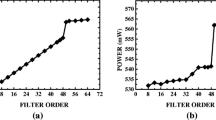Abstract
In this paper, we propose an AND/XOR-based technology mapping method for efficient realization of parity prediction functions in field programmable gate arrays (FPGAs). Due to the fixed size of the programmable blocks in an FPGA, decomposing a circuit into sub-circuits with appropriate number of inputs can achieve an excellent implementation efficiency. Specifically, the proposed technology mapping method is based on Davio expansion theorem. The AND/XOR nature of the proposed method allows it to operate on XOR intensive circuits, such as parity prediction functions, efficiently. We conduct experiments using the parity prediction functions with respect to MCNC benchmark circuits. With the proposed approach, the number of configurable logic blocks (CLBs) is reduced by 67.6% (compared to speed-optimized results) and 57.7% (compared to area-optimized results), respectively. The total equivalent gate counts are reduced by 65.5%, maximum combinational path delay is reduced by 56.7%, and maximum net delay is reduced by 80.5% compared to conventional methods.
Similar content being viewed by others
References
M. Abramovici, C. Stroud, S. Wijesuriya, C. Hamilton, and V. Verma, “Using Roving STARs for On-Line and Diagnosis of FPGAs in Fault-Tolerant Applications,” in Proc. ITC, Oct. 1999, pp. 973–982.
C. Bolchini, F. Salice, and D. Sciuto, “A Novel Methodology for Designing TSC Networks Based on the Parity Bit Code,” in Proc. European Design and Test Conf., March 1997, pp. 440–444.
J. Cong and Y. Ding, “Combinational Logic Synthesis for LUT Based Field Programmable Gate Arrays,” ACMTransactions on Design Automation of Electronic Systems,vol. 1, no. 2, pp. 145–204, April 1996.
J. Cong and Y.Y. Hwang, “Boolean Matching for Complex PLBs in LUT-Based FPGAs with Application to Architecture Evaluation,” in Proc. ACM 6th Int'l Symposium on FPGA, Feb. 1998, pp. 27–34.
R. Cuddapah and M. Corba, Reconfigurable Logic for Fault Tolerance, Springer-Verlag, 1995.
S. Even, I. Kohavi, and A. Paz, “On Minimal Modulo-2 Sums of Products for Switching Functions,” IEEE Transactions on Electronic Computers,vol. EC-16, pp. 671–674, Oct. 1967.
F. Hanchek and S. Dutt, “Methodologies for Tolerating Logic and Interconnect Faults in FPGAs,” IEEE Trans. on Computers, vol. 47, no. 1, pp. 15–33, Jan. 1998.
M. Helliwell and M. Perkowski, “A Fast Algorithm to Minimize Multi-Output Mixed-Polarity Generalized Reed-Muller Forms,” in Proc. ACM/IEEE Design Automation Conf., 1988, pp. 427–432.
W.K. Huang, F.J. Meyer, X. Chen, and F. Lombardi, “Testing Configurable LUT-Based FPGAs,” IEEE Trans. on VLSI Systems, vol. 47, no. 6, pp. 276–283, June 1998.
S.B. Ko and J.C. Lo, “Efficient Decomposition Techniques for FPGAs,” in IEEE Int'l Conf. on High Performance Computing, Dec. 2002.
S.B. Ko, T. Xia, and J.C. Lo, “Efficient Error Prediction in FPGA,” in IEEE Int'l Symposium on Defect and Fault Tolerance in VLSI Systems, Oct. 2001, pp. 176–181.
J.C. Lo, M. Kitakami, and E. Fujiwara, “Reliable Logic Circuits Using Byte Error Control Codes,” in Proc. Int'l Symposium on Defect and Fault Tolerance in VLSI Systems, Oct. 1996, pp. 286–294.
T. Sasao, Logic Synthesis and Optimization, Kluwer Academic Publishers, 1998.
T. Sasao and P. Besslich, “On the Complexity of MOD-2 Sum PLAs,” IEEE Trans. on Computers,vol. 32, no. 2, pp. 262–266, Feb. 1990.
N.A. Touba and E.J. McCluskey, “Logic Synthesis of Multilevel Circuits with Concurrent Error Detection,” IEEE Transactions on Computer-Aided Design,vol. 16, no. 7, pp. 783–789, July 1997.
Xilinx Inc., http://www.xilinx.com.
Xilinx Inc., Xilinx Data Book: XC4000E and XC4000X Series, May 1999.
Author information
Authors and Affiliations
Rights and permissions
About this article
Cite this article
Ko, SB., Lo, JC. Efficient Realization of Parity Prediction Functions in FPGAs. Journal of Electronic Testing 20, 489–499 (2004). https://doi.org/10.1023/B:JETT.0000042513.15382.e7
Issue Date:
DOI: https://doi.org/10.1023/B:JETT.0000042513.15382.e7




